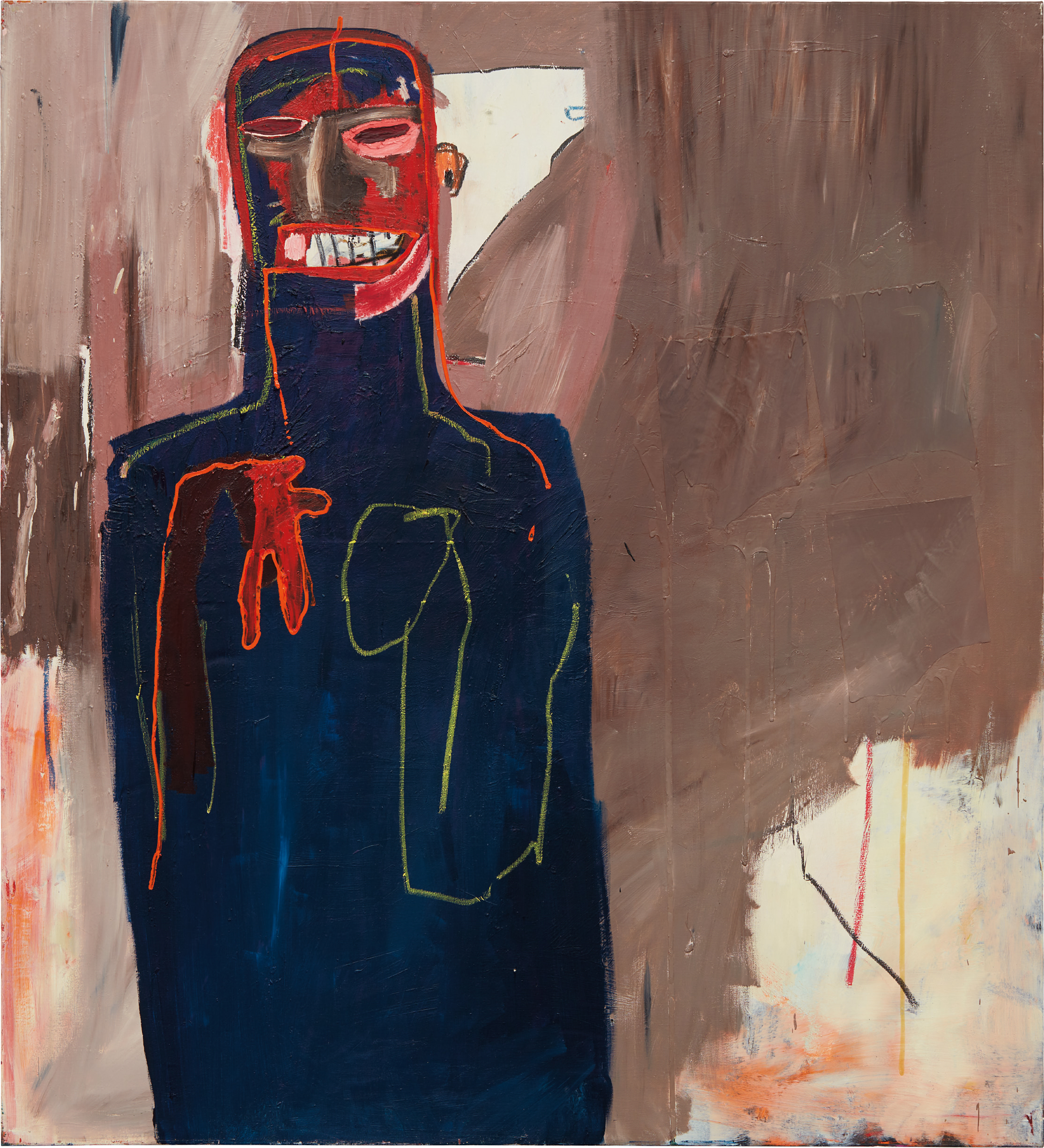

11
Jean-Michel Basquiat
Untitled
Full-Cataloguing
Executed in 1984, Untitled was created at the height of Basquiat’s notoriously short but prodigious artistic career that ended with his untimely death five years later. By 1984, the year of Untitled’s creation, Basquiat already had five major solo shows across America, Europe, and Japan under his helm and was the youngest artist - at 23 years of age - ever to be included in the Whitney Biennial; only a year later his iconic stature graced the cover of the The New York Times Magazine.
Untitled perfectly articulates the raw, unfiltered expressionism, painterly energy and sheer breadth of artistic virtuosity that garnered Basquiat critical acclaim. Basquiat’s distinctive visual idiom is the result of a compulsive and intuitive process, one which borrows liberally from such disparate fields as urban street culture, music, poetry, African-American and Aztec cultural histories and a broad range of art historical sources. In the present work, the artist's signature use of pentimento - i.e. the presence of earlier gestures, scrapes, forms, or strokes that have been changed and painted over - results in a powerful and compelling portrait that brilliantly fuses the figurative with the abstract. The crudely depicted face belies Basquiat’s admiration for anti-establishment artist Jean Dubuffet, whose rejection of traditional portraiture and the dictum “I believe very much in value of savagery; I mean: instinct, passion, mood, violence, madness" Basquiat voraciously pursued in Untitled specifically evokes Dubuffet’s acclaimed early portraits from the late 1940s and 50s, in which his subject’s contours were scratched like graffiti into a densely covered canvas. As Rene Ricard aptly observed in his seminal Artforum essay: ”If Cy Twombly and Jean Dubuffet had a baby and gave it up for adoption it would be Jean-Michel. The elegance of Twombly is there [and] from the same source (graffiti) and so is the brut of the young Dubuffet. Except the politics of Dubuffet needed a lecture to show, needed a separate text, whereas in Jean-Michel they are integrated by the picture's necessity" (Rene Ricard, "The Radiant Child," Artforum, December 1981, p. 35).
As with another seminal painting from the same time period, Untitled (High Museum of Art, Atlanta), the present work stands out within the scope of Basquiat’s oeuvre for its focus on a singular, frontally-portrayed figure and its high degree of chromatic nuance and abstraction. In stark contrast to the frenetic canvases of Basquiat’s earlier years, Untitled puts forward a more serene composition. Indeed, the juxtaposition of the blue color block against the expressively painted swaths of color lend the painting a chromatic balance that is a rare for Basquiat’s work. Formally evoking such works such as Franz Kline’s Black Reflections, 1959, (Metropolitan Museum of Art, New York), or Willem de Kooning’s Suburb in Havana, 1958, Untitled thereby articulates the lasting influence of Abstract Expressionism on Basquiat’s practice. As his artistic AbEx forebearers, Basquiat sought to distill a certain spiritual and fundamental truth in his work. Engaging in a radically different social milieu and historical context, however, Basquiat did so by seeking the expressive potential within figuration - developing a distinctive iconoclastic idiom that drew from both the past and present.
Untitled is testament to the centrality that the human figure – particularly in the guise of a black man – takes in Basquiat’s inimitable oeuvre."Basquiat's canon”, as Kellie Jones has noted, "revolves around single heroic figures: athletes, prophets, warriors, cops, musicians, kings and the artist himself. In these images the head is often a central focus…In this way the intellect is emphasized, lifted up to notice, privileged over the body and the physicality of these figures (i.e. black men) commonly represented in the world”(Kellie Jones, Lost in Translation: Jean-Michel in the (Re)Mix. vol xx, no. 4, December 1981, p. 43).In the present work, the heavily worked abstract background ultimately serves the purpose of pushing the figure to the forefront of the composition and thus forcing the viewer’s attention on the frenzied execution of the enigmatic figure. Appearing as a mysterious apparition, the figure in Untitled is a powerful example of Basquiat’s so-called “icons”, which, as Marc Mayer observed, "seem improvised and spontaneous, as you would expect of an invocation, or of graffiti…The many works in this “icon” category have a familiar ritual function, not unlike the West African sculptures and masks that Basquiat collected when he traveled there, the functional Vodoun and Santeria figures of his Caribbean roots that descended from them, or Western religious icons and statuettes meant to embody a given saint or represent Jesus Christ.”(Marc Mayer, “Basquiat in History”, Basquiat, New York, 2005, p. 51). Whilst putting forward a variety of different iconographies, Basquiat’s portraits are ultimately always autobiographical in some way - exorcising creative demons, exposing the artist’s own fears and anxieties. “I don’t think about art when I’m working”, Basquiat once answered when questioned on his method of constructing an image, “I try to think about life” (Jean-Michel Basquiat, quoted in Basquiat, exh. cat., Museo Revoltella, Trieste, 1999, p. lxvii).
Jean-Michel Basquiat
American | B. 1960 D. 1988One of the most famous American artists of all time, Jean-Michel Basquiat first gained notoriety as a subversive graffiti-artist and street poet in the late 1970s. Operating under the pseudonym SAMO, he emblazoned the abandoned walls of the city with his unique blend of enigmatic symbols, icons and aphorisms. A voracious autodidact, by 1980, at 22-years of age, Basquiat began to direct his extraordinary talent towards painting and drawing. His powerful works brilliantly captured the zeitgeist of the 1980s New York underground scene and catapulted Basquiat on a dizzying meteoric ascent to international stardom that would only be put to a halt by his untimely death in 1988.
Basquiat's iconoclastic oeuvre revolves around the human figure. Exploiting the creative potential of free association and past experience, he created deeply personal, often autobiographical, images by drawing liberally from such disparate fields as urban street culture, music, poetry, Christian iconography, African-American and Aztec cultural histories and a broad range of art historical sources.